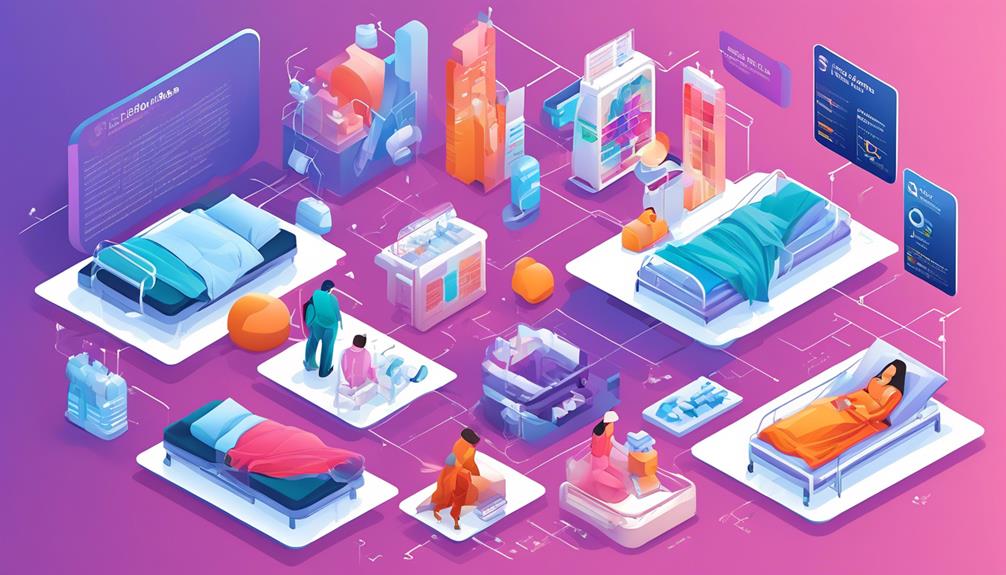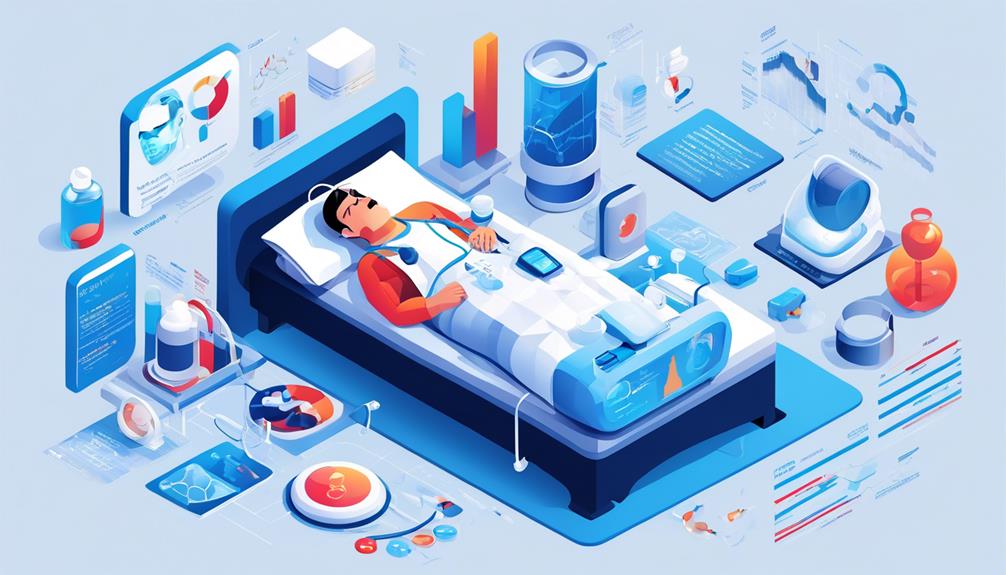As I was driving through a dense fog the other day, it struck me that sleep apnea is like trying to breathe through a thick mist, never quite getting enough air to feel fully awake.
The statistics surrounding sleep apnea are both eye-opening and concerning, shedding light on a condition that often goes undiagnosed. With millions of Americans affected and a staggering percentage unaware of their condition, it's clear that there's more to this issue than meets the eye.
Key Takeaways
- Sleep apnea affects approximately 6.62% of the total American population.
- The majority of cases of sleep apnea remain undiagnosed.
- Certain races, such as Asians, African Americans, Native Americans, and Hispanics, have a higher risk for sleep apnea.
- Untreated sleep apnea increases the risk of stroke four times and sufferers are three times more likely to have heart disease.
Prevalence of Sleep Apnea
Sleep apnea affects approximately 6.62% of the total American population, with the majority of cases remaining undiagnosed. This condition is more prevalent in men, particularly those who are overweight and middle-aged. African Americans also have a higher risk of obstructive sleep apnea compared to Caucasians.
The impact of sleep apnea extends beyond individual health, with drowsy driving due to this condition causing at least 100,000 car accidents, 40,000 injuries, and 1,550 deaths annually in the United States.
Children are also affected, with more than 263,000 tonsillectomies performed each year due to sleep apnea caused by obstructed airways. The consequences of untreated sleep apnea are severe, as it increases the risk of stroke fourfold and is associated with heart disease, hypertension, and approximately 38,000 deaths related to cardiovascular problems annually.
These statistics highlight the widespread nature of sleep apnea and emphasize the urgent need for increased awareness, early diagnosis, and effective management of this condition.
Demographics and Risk Factors

With the prevalence of sleep apnea being higher in certain demographics and individuals with specific risk factors, it's essential to understand the various factors that contribute to the development of this sleep disorder. As revealed by sleep apnea statistics, certain demographics and risk factors play a significant role in the likelihood of developing this condition:
- Age and Gender: Sleep-disordered breathing is more common in older men, indicating that age and gender are important demographic factors in the prevalence of sleep apnea.
- Race: Certain races, such as Asians, African Americans, Native Americans, and Hispanics, have a higher risk for sleep apnea, highlighting the influence of race on the likelihood of experiencing this disorder.
- Weight: Overweight individuals are at a higher risk for sleep apnea, emphasizing the impact of weight on the development of this condition.
- Health Status: People with chronic diseases or weakened health are more prone to sleep apnea, underscoring the relationship between health status and the risk of this sleep disorder.
- Substance Use: Those who use cigarettes, alcohol, or drugs have an increased risk of sleep apnea, emphasizing the impact of substance use on the likelihood of experiencing this condition.
Signs and Symptoms
Experiencing signs and symptoms of sleep apnea can be a cause for concern and may indicate the presence of a potentially serious sleep disorder. For those with obstructive sleep apnea, common symptoms include:
- Loud snoring
- Excessive daytime sleepiness
- Morning headaches
- Dry mouth
- Restless sleep
On the other hand, individuals with central sleep apnea may experience:
- Breathing problems
- Daytime sleepiness
- Frequent awakenings at night
- Chest pains
- Difficulty focusing
It's crucial to recognize these signs as sleep apnea can lead to physical and functional changes in the brain stem. Moreover, if left untreated, it can result in various health complications such as:
- Heart failure
- Arrhythmias
- Sudden cardiac death
- Fatigue
- High blood pressure
- Heart problems
- Type 2 diabetes
- Metabolic syndrome
- Liver problems
Additionally, untreated sleep apnea also poses an increased risk of car accidents due to daytime drowsiness. However, the good news is that treating sleep apnea can significantly improve heart health and reduce the risk of cardiovascular complications. Therefore, it's important to be aware of these signs and symptoms and seek the necessary medical attention for proper diagnosis and treatment.
Health Risks Associated With Sleep Apnea

The health risks associated with sleep apnea can have serious implications for individuals' cardiovascular and overall well-being.
- Untreated sleep apnea increases the risk of stroke four times and sufferers are three times more likely to have heart disease.
- Roughly half of all hospital patients with hypertension also have sleep apnea, while half of all sleep apnea sufferers have a diagnosis of hypertension.
- Approximately 38,000 deaths related to cardiovascular problems connected to sleep apnea occur annually.
- Untreated sleep apnea increases the risk of hypertension, heart disease, and stroke, and is associated with an increased risk of cancer and metabolic syndrome.
- Treating affected drivers with sleep apnea could save 980 lives annually.
These statistics underscore the severity of health risks associated with sleep apnea. The increased risks of stroke and heart disease, coupled with the high prevalence of hypertension among sleep apnea sufferers, emphasize the need for timely diagnosis and effective treatment.
Understanding these health risks can encourage individuals to seek medical attention and adhere to prescribed therapies, ultimately reducing the potential impact of sleep apnea on their overall health.
Treatment Options
What are the most effective treatment options for sleep apnea?
The most common and effective treatment for sleep apnea is the use of a Continuous Positive Airway Pressure (CPAP) machine. This device helps keep the airways open during sleep by delivering a continuous flow of air through a mask.
Oral appliances, which reposition the jaw and tongue to keep the airway open, are also a popular treatment option.
In some cases, surgery may be recommended to address anatomical issues contributing to sleep apnea.
Additionally, positional therapy, which involves changing sleep positions to prevent airway blockage, can be beneficial for certain individuals.
Lifestyle changes such as weight loss, regular exercise, and avoiding alcohol and sedatives can significantly improve sleep apnea symptoms.
It's important to note that alternative therapies like acupuncture and hypoglossal nerve stimulation are currently being studied as potential treatment options.
Ultimately, the most effective treatment option for sleep apnea varies from person to person, and it's essential to consult with a healthcare professional to determine the most suitable approach.
Economic Impact

Sleep apnea's economic impact extends beyond healthcare costs, affecting various aspects of society, including transportation, productivity, and healthcare expenditures. The economic ramifications of sleep apnea are significant and wide-reaching.
- Sleep apnea contributes to an estimated 100,000 car accidents, 40,000 injuries, and 1,550 deaths annually, leading to substantial economic impact.
- Sleep apnea-related obstructed airways result in over 263,000 tonsillectomies in children each year, leading to significant healthcare costs and potential productivity losses for parents.
- Untreated sleep apnea significantly increases the risk of stroke, heart disease, and hypertension, leading to increased healthcare costs and potential loss of productivity.
- Sleep apnea is associated with an increased risk of hypertension, heart failure, arrhythmias, and sudden cardiac death, leading to high healthcare costs and potential loss of productivity for affected individuals.
- Treating all affected drivers with sleep apnea could save an estimated 980 lives annually, reducing potential economic losses associated with accidents and fatalities.
The economic burden of sleep apnea isn't limited to healthcare expenses but also encompasses a wide range of societal costs, making it essential to address this condition comprehensively.
Epidemiology and Mortality

Considering the significant impact of untreated sleep apnea on mortality and its association with cardiovascular disease and stroke, it's crucial to understand the epidemiology of this condition.
Untreated sleep apnea increases the risk of death by three times and is attributed to about 42% of related deaths being due to cardiovascular disease or stroke. Annually, around 38,000 deaths related to cardiovascular problems connected to sleep apnea occur.
Moreover, sleep apnea causes widespread inflammation throughout the body and is linked to cardiovascular disease and stroke. It's alarming that drowsy driving due to sleep apnea causes at least 100,000 car accidents, 40,000 injuries, and 1,550 deaths annually.
Sleep-disordered breathing is more common in older men, and certain races, such as Asians, African Americans, Native Americans, and Hispanics, have a higher risk for sleep apnea.
Understanding the epidemiology of sleep apnea is crucial in implementing preventive measures and ensuring timely diagnosis and treatment.
These statistics underscore the critical need for increased awareness and interventions to mitigate the impact of sleep apnea on mortality and public safety.
Frequently Asked Questions
Can Sleep Apnea Be Hereditary, and if So, What Are the Chances of a Family Member Developing the Condition?
Yes, sleep apnea can be hereditary. If a family member has it, chances of others developing it increase. Factors like family history, age, gender, and genetics play a role, making it important for relatives to be aware.
Are There Any Specific Occupations or Industries That Have a Higher Prevalence of Sleep Apnea?
In some jobs with irregular hours, high stress, sedentary work, or exposure to environmental factors, there's a higher prevalence of sleep apnea. Certain industries like commercial driving, shift work, high-pressure corporate roles, manufacturing, and frequent travel are associated.
How Does Sleep Apnea Affect Mental Health and Emotional Well-Being?
Sleep apnea affects mental health and emotional well-being by causing fatigue and irritability, impacting overall mood. It's like trying to function on an empty tank of gas, affecting daily life and relationships.
Are There Any Alternative or Complementary Therapies That Have Been Found to Be Effective in Managing Sleep Apnea Symptoms?
Yes, some alternative therapies like acupuncture, hypoglossal nerve stimulation, and positional therapy have shown promise in managing sleep apnea symptoms. It's important to consult with healthcare professionals to determine the most suitable treatment approach.
What Are the Long-Term Effects of Untreated Sleep Apnea on Overall Health and Quality of Life?
Untreated sleep apnea can lead to serious health issues like stroke, heart disease, and diabetes. It also affects quality of life, causing fatigue, morning headaches, and mental health problems. It's crucial to address.
Conclusion
In conclusion, sleep apnea statistics are alarming, with millions of people affected and a majority undiagnosed. It's like a silent predator, lurking in the night, causing potential health risks and impacting individuals' well-being.
It's crucial to raise awareness, encourage screenings, and seek treatment to prevent the potential dangers of untreated sleep apnea. Let's not let this condition continue to go undetected and untreated.










